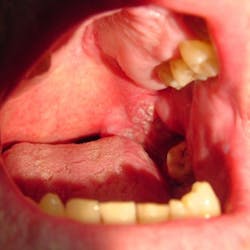Google revealed that their private Google[x] lab has been working on a wearable device that works with nanotechnology to detect disease within the body.(1) Google X, stylized as Google[x], is a semi-secret facility run by Google dedicated to making major technological advancements. It is located about a half mile from Google's corporate headquarters, the Googleplex, in Mountain View, Calif.(2) Google[x] has already developed a smart contact lens that detects glucose levels for diabetics, as well as utensils that help manage hand tremors in Parkinson’s patients.
The goal of this new device is to assess if minute particles coated or “magnetized” with antibodies can detect disease in its budding stages. The tiny particles are basically programmed to spread throughout the body in pill form and then attach to the abnormal cells. The wearable device then “calls” the nanoparticles back to obtain information and to ascertain if the person who swallowed the pill has cancer or other diseases.(1) For more on Google’s Hybrid Approach to Research, view an explanatory document their website.(3)
Also in the area of prevention and early intervention, there are cancer vaccines. Vaccines are intended to increase the body’s natural ability to protect itself through the immune system from vulnerabilities caused by damaged or abnormal cells such as cancer cells. The U.S. Food and Drug Administration (FDA) has approved two types of vaccines to prevent cancer:
- • Vaccines against the hepatitis B virus, which can cause liver cancer
- • Vaccines against human papillomavirus types 16 and 18, which are responsible for about 70 percent of cervical cancer cases(4)
The FDA has approved one cancer treatment vaccine for certain men with metastatic prostate cancer. Researchers are developing treatment vaccines against many types of cancer and testing them in clinical trials.
A study published online on Nov. 6 detailed how chronic dental irritation could have significance in the development of oral cancers, especially in nonsmokers.(5) A major finding of the study was that the location where oral cancers arise differs in smokers and nonsmokers. In nonsmokers, cancers tend to be found in areas where teeth or dentures can rub and cause irritation. In smokers, most the majority of the cancers were on the lateral border of the tongue, on the floor of the mouth, and in the retromolar trigone area.(5)
The study’s authors mentioned that a fairly high incidence of oral squamous cell carcinoma in nonsmokers has been documented, especially in women who are nonsmokers or do not have other recognized risk factors. As we know, smoking and alcohol are recognized causal influences in the growth of oral malignancies. The human papillomavirus (HPV) has also been proven to be a carcinogen in the oropharyngeal area; however, the study did not clarify the role of HPV in other oral cancers.
During the 10-year study, the incidence of oral cancer (front of the mouth) in women was almost twice that of oropharyngeal cancer. In men, the incidence of oral and oropharyngeal cancer was similar. For nonsmokers, oral lesions were more common in women than men. In smokers, oral lesions were less common in women. In nonsmoking men, the number of cases of oropharyngeal and oral cancer were similar (36 vs. 34 cases). However, in female nonsmokers, there were four times as many cases of front of the mouth as oropharyngeal cancer.(5)
It was noted that epithelial warts caused by HPV are known to insert at sites of trauma. It was concluded that HPV could be a possible cocarcinogen along with dental trauma, such as that caused by dentures. The bottom line is that we need to counsel patients that chronic irritation may be a significant factor in the development of carcinogenic tumors in the mouth and in different places in the body. Women are particularly susceptible to oral cancer, even when they do not smoke. Also cancers occur more often on the lateral border of the tongue in young people, and where dentures rub in elderly people.
And finally, an immune-related gene called transforming growth factor beta receptor 1 (TGFBR1) has been identified that seems to have influence in defining whether a person develops HPV-related cancer.(6) Approximately 70% of an estimated 33,000 oropharyngeal cancer cases in the United States yearly are said to be caused by HPV, a common sexually transmitted infection.(7) Studies show that most patients with oropharyngeal squamous cell carcinoma (OPSCC) are HPV-positive, especially for HPV types 16 and 18.(8) While most people are exposed to the HPV, not all get cancer. In this study researchers were able to associate alterations in a number of immune-related genes with oropharyngeal cancer. One of these genes, TGFBR1, was found to be deregulated in patients with both oropharyngeal and cervical cancers.(6)
References
- http://techcrunch.com/2014/10/28/googlex-reveals-nano-pill-to-seek-out-cancerous-cells/.
- http://research.google.com/.
- http://static.googleusercontent.com/media/research.google.com/en/us/pubs/archive/38149.pdf.
- http://www.cancer.gov/cancertopics/factsheet/Therapy/cancer-vaccines?utm_content=sf32581240&utm_medium=spredfast&utm_source=facebook&utm_campaign=National+Cancer+Institute&cid=sf32581240#q6.
- Perry BJ, Zammit AP, Lewandowski AW, et al. Sites of Origin of Oral Cavity Cancer in Nonsmokers vs Smokers Possible Evidence of Dental Trauma Carcinogenesis and Its Importance Compared With Human Papillomavirus. JAMA Otolaryngol Head Neck Surg. doi:10.1001/jamaoto.2014.2620. Published online November 6, 2014.
- Levovitz C, Chen C, Ivansson E, et al. TGFBR1 and other immune-related genes modify susceptibility to HPV-associated head and neck cancer. [abstract]. In: Proceedings of the 105th Annual Meeting of the American Association for Cancer Research; 2014 Apr 5-9; San Diego, CA. Philadelphia (PA): AACR; Cancer Res 2014;74(19 Suppl):Abstract nr 4175. doi:10.1158/1538-7445.AM2014-4175.
- http://www.cdc.gov/cancer/hpv/statistics/cases.htm.
- van Kempen PMW, van Bockel L, Braunius WW, et al. HPV-positive oropharyngeal squamous cell carcinoma is associated with TIMP3 and CADM1 promoter hypermethylation. Cancer Medicine 2014; 3(5): 1185–1196.









